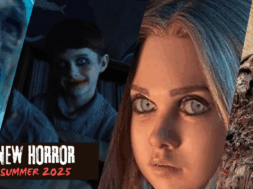‘I Have No Mouth, and I Must Scream’: The Most Disturbing, Nihilistic Video Game of All Time?

We shine a light on the highly controversial, deeply ambitious Harlan Ellison video game adaptation that was decades ahead of its time.
When was the last time that a video game really got in your head and made you question your every decision? Sure, there are plenty of survival horror games that succeed in frightening their audience with monsters and surprising jump scares, but how many horror games frighten the gamer because of the very decisions that they make and the sort of person that they’re becoming? Sure, zombies and ghosts are terrifying, but human nature and how twisted and evil people can become is even scarier and there are very few games that even attempt to examine that area in horror. Not only does Harlan Ellison’s I Have No Mouth, and I Must Scream make a stake for that territory, but they succeed in a hugely ambitious way.
“I have a secret game that I’d like to play. It’s a very nice game. Oh, it’s a lovely game, a game of fun and a game of adventure. A game of rats and lice and the Black Death. A game of speared eyeballs and dripping guts and the smell of rotting gardenias.” Welcome to the subtle, restrained world of I Have No Mouth, and I Must Scream
If that excerpt isn’t enough of a glimpse into this game’s bitter tone, the title has the privilege of featuring one of the most over the top, melodramatic introductions that I’ve ever seen in a point-and-click adventure game. This is all also heightened and made even better by Harlan Ellison’s huge voice acting performance as the rabid supercomputer AM. Ellison wanted I Have No Mouth, and I Must Scream to wear its bleak nature on its sleeve, but listen to the joyful, flowery dialogue that kicks off this game:
“Hate. Let me tell you how much I’ve come to hate you since I began to live. There are 387.44 million miles of printed circuits in wafer thin layers that fill my complex. If the word ‘hate’ was engraved on each nanoangstrom of those hundreds of millions of miles it would not equal one one-billionth of the hate I feel for humans at this micro-instant. For you. Hate. Hate.”
That might be too nihilistic for even the most hardcore of Ellison junkies. The game basically spends close to ten minutes setting up its five main characters, who are all stuck in their own personal Hells and eager to finally escape. The pessimistic catch to all of this is that the only way to escape is for these individuals to finally be allowed the privilege to kill themselves after 109 years of torture. Furthermore, AM has extreme sentience, but it’s confined to its state and can’t move in the real world. That’s AM’s ultimate goal and the reason why it tortures these people. It longs to figure out a way to no longer be a “quadriplegic.”

This isn’t the worst premise for a horror game—it’s like an extreme version of the typical point-and-click fare. Picture a scenario where Jigsaw is essentially God and rather than putting his victims through ironic torture rooms he instead creates a whole alternate reality torture simulation to drive them insane. Each character gets transported to a new constructed world, whether it’s a Zeppelin, an Egyptian pyramid, a medieval castle, or a prehistoric cave, and then they must work out the puzzles. That’s a freaking awesome setup for a video game.
I Have No Mouth, and I Must Scream focuses its gameplay around the ethical and moral decisions that the player makes through their experience. This is a concept that’s slowly made its way into video games like Fable through the years, but it’s still a relatively deep concept to try and work into a video game, especially back in the ‘90s. However, there’s also a pretty good chance that I Have No Mouth, and I Must Scream is probably the only video game that’s available to play in The Good Place.
This title also stands out because it’s a rare example where the relationship between the original author and the adaptation is actually quite deep. In fact, Ellison was so deeply involved in the production of this game that he even acts as the voice of the title’s vengeful God, AM. It makes for a wonderful example of art imitating life and the game takes on an ultra-real level of meta-commentary as a result, which is always appreciated in Ellison’s works.
I Have No Mouth, and I Must Scream led to a lot of discussions ever since it was first announced. The game was a big deal due to being co-designed by Ellison and published by the company Cyberdreams. The game stood out for the fact that it was put together by a number of talents that weren’t from the world of video games. David Sears, who wrote the game with Ellison, came from Compute! Magazine as a writer and associate editor. Furthermore, many people in the industry considered Ellison’s stories impossible to adapt for video games, let alone a story like I Have No Mouth, and I Must Scream that already contains scarce character details. It was this decision to flesh out the characters that led to the development decision to use a unique split narrative structure for the story. In that sense the game almost functions as a sequel or origin story of sorts for Ellison’s original text.
Sears and Ellison prepared a 130-page draft document that would work as the script and outline for the game. Then, producer David Mullich (who’s now most commonly known for his work in the Heroes of Might and Magic series) would take this document and transform it into a massive 800-page design document with over 2000 lines of additional dialogue. This was not typical for games of this time, which is another reason why I Have No Mouth is such an interesting anomaly. Mullich seemed like the right person to help with the controversial title as he had previously worked on a video game adaptation of the mind-bending television series, The Prisoner, which is an equally ambitious project for when it came out in 1980 (seriously, the game gets in players’ heads so thoroughly that the CIA even used it as a training tool). Both I Have No Mouth and The Prisoner also heavily pull from Franz Kafka’s mindfuck of a novel, The Castle. The Prisoner game also involves surreal storytelling techniques, an emphasis on philosophy, and puts stock in the moral values of the gamer.

In pre-release publicity for the title, Ellison went so far as to say that this was a game that “you cannot possibly win.” This stirred up a considerable amount of controversy and the final product eventually balked from this boast. The game can be won, but it’s difficult, and there are an abundance of negative endings. It also didn’t help that Ellison’s approach here was to basically attack the computer gaming industry and say that his game would be the first breath of fresh air in some time and finally something new for gamers.
Sears was eventually able to get through to Ellison and convince him that a game with purely bad endings wouldn’t be appreciated, but it’s a bold premise that jives with the author’s work. Even still, in 2013 Ellison stood by his actions and said, “I created it so you could not win it. The only way in which you could ‘win’ was to play it nobly. The more nobly you played it, the closer to succeeding you would come, but you could not actually beat it. And that annoyed the hell out of people too.” In that sense this indicates that Ellison’s perception of the “good ending” where AM is defeated and the cryogenically frozen humans wake up on Luna is still steeped in dread. Or maybe he just never knew they pushed through this happy ending angle.
I Have No Mouth, and I Must Scream is also innovative in the sense that each character’s narrative put to use a different art style that would better reflect that character’s themes. German expressionism, flowery high fantasy, and ultra-drab realities are all used to better illustrate the personal Hells that each of these people are trapped in, as well as highlight the immense, surreal powers of AM. The title also impresses with some really incredible voice acting, sound design, and a full score. Mullich hired film composer John Ottman (who would later do musical work on The Usual Suspects and X-Men) to write over 25 pieces of original MIDI music, and it really stands out.
The game was a critical success for the most part (GameSpot awarded it a 4.3 out of 5 and PC Gamer gave it an 87%) although it still fell flat for some audiences. It was described as “less a game than an ethical obstacle course,” which is actually a pretty perfect description of it (and also a review that Ellison probably would have loved). While the game was too deep for some, many praised its ambitious nature and even went as far as to say that this is what high art should do. If video games want to be taken seriously, then they need to offer the same level of reflection and analysis that the works of Kafka do, for example.
It’s factors like that that helped the title receive such accolades as “Best Game Adapted from Linear Media” at that year’s CGDC and Computer Gaming World even called it “Adventure Game of the Year.” Even now the game still carries on a strong legacy and as recently as 2014 Game Informer put it amongst its “Top 25 Horror Games of All Time.” Back in the summer of 1995, a PlayStation port of the title was planned, but ultimately canceled. Such a release surely would have helped widen the visibility of this cult title. Fortunately, the game has recently found a second life on Steam and GOG.com after it was released on the platforms back in 2013.

When it comes down to the actual gameplay, there are definitely pangs of System Shock here, but there’s ultimately a deeper story in place that actually plays into the moral decision making process that BioShock had such a ball with. The game also has a very Eternal Darkness feeling to it in terms of its “episodic” nature. The title is split up into five stories (which are referred to as psycho-dramas, which is great), that are all about 30 minutes or so in length. All of this amounts to an experience that feels like an anthology horror approach to an adventure game, which really should be done more! Even if this was a messy disaster, this would still be a concept that has merit, but I Have No Mouth knocks it out of the park. It’s a real surprise that this title’s structure didn’t inspire more horror-adventure games that follow a similar vein.
All of the moral quandaries and decision-making results in a total of seven different possible endings for the game that are based on the player’s performance. This is also a feature that was incredibly ahead of its time. A majority of the players had no idea how many different endings were out there, let alone the steep conditions necessary to arrive at the game’s infamous “good” ending.
Extreme topics like animal torture, human experimentation, genocide, rape, and mental illness all get explored here to surprising degrees. It’s also really wonderful that the game makes it so you don’t know who to trust in the storylines and basically everything is treated as suspect. The fact that there are multiple ways to get through everything also gives the title a ton of replay value and it’s rather ingenious that the game’s hint system expresses its ideas as actual riddles rather than holding your hand to success.
On that note, the game’s puzzles are very obtuse and difficult (one infamous examples involves needing to flush a toilet three times to unlock a hidden room, with no explanation behind the action), but even more so than the typical ‘90s point-and-click adventure game kind of way. This makes the experience even more frustrating at times, but it feels like that’s what Ellison wants to happen. To be fair, the game is far from perfect, there are plenty of programming bugs, and it’s not exactly a smooth adventure game experience, but this title just gets so many points for atmosphere and style that it’s easy to look past these things. There are all sorts of buggy games from the ‘90s, what’s important here is that this is one of the few that gets psychological with its audience and taps into some true horror with lasting ramifications.

All of the storylines in the title offer a glimpse of a different uncomfortable area that Ellison wishes to rub in the audience’s face. There are pretty clear-cut goals that are in place for each character, but it’s the effort put into the details that really make all of this stand out. In Gorrister’s story, he deals with jukeboxes in his purgatory that only play pained audio tracks of his loved ones and past mistakes, which is a brilliantly twisted idea. At another point, a character is forced to reunite and confront their loved ones as they hang in a meat locker. Each of these little morality plays force your character to confront their past in some disturbing way.
Ellen’s story is particularly painful as it attempts to portray mental illness to questionable, albeit admirable, results, especially for a ‘90s point-and-click adventure game. The scenario goes through Ellen’s sad life and her struggle with postpartum depression. The most shocking part of all of this occurs when Ellen is forced to face her traumatic rape head-on and re-live an aggressive attack in an elevator that explains why she’s become so frail. It’s incredibly dark, especially with how it glosses over Ellen’s entire life and the downward spiral that it takes, but it makes for fairly challenging material for a video game.
Benny sees himself transformed into a handicapped ape creature, which is particularly morbid. What’s worse is that his mission deals with having to choose a villager to sacrifice to AM on the altar. At the same time, Benny also helps raise a mutant child, who inevitably loses their mother to the lottery sacrifice. In a 2012 Game Informer interview, it was revealed that there were regrets that Benny’s story wasn’t more of a parable for someone trying to come to terms with their homosexuality (which was apparently in the game’s original script), which would have seen the game hit on yet another controversial, yet important, area.
Nimdok’s scenario is especially depressing as he’s a Nazi scientist who happens to work with Dr. Joseph Mengele. Things get real dark with Nimdok and he’s stuck in a position where AM wants to retrieve the doctor’s impressive torture techniques for his own gain. It’s one thing for a storyline to simply talk about the atrocities of Nazis, but Nimdok’s task here is to take spinal fluid from children to help build a secret Nazi serum. Meanwhile, the character gets to spout optimistic lines of dialogue like, “I smell burnt flesh, but this definitely isn’t a kitchen. Nimdok even gets smaller moments to marvel at the corpses that were able to smuggle possessions so far in life. There’s literally a scene in this where a bunch of Jewish children scream at Nimdok for the human experiments that he and Mengele do. One child has even had his eyes surgically removed! Curiously, this material goes so far that Nimdok’s story is removed entirely from the French and German versions of the game for understandably delicate purposes. However, it also means that players can’t get the best ending in those versions of the game either!

Finally, the character Ted is meant to be the “normal” narrator and the audience surrogate. I Have No Mouth pushes the premise that normal, regular people are just as messed up and disturbed as the rest of AM’s prisoners. Ted needs to navigate through a fairytale-like narrative and rescue a damsel in distress with Ted playing the Prince Charming role. There are witches, a literal devil, and Cinderella allusions galore here, all of which add a very surreal quality to the tale.
Once the title has made gamers work through each of these twisted examples of psychological torture porn, it adopts a very Harlan Ellison-esque finale. The characters all get digitized into computer viruses and the supercomputer gets to utter something as jokingly poignant as, “I THINK THEREFORE I AM NOT.” All of this also involves the player going into a giant brain and disabling its ego, lest “your subprogram get purged.” Pure Ellison porn, plain and simple.
I Have No Mouth, and I Must Scream made a strong name for itself upon release, but unfortunately, The Dreamers Guild wouldn’t really garner much of a reputation after the title’s release. The team followed up I Have No Mouth with a middling DinoTopia title and then went on to fade into obscurity. It’s a shame that the company couldn’t pull together one final collaboration with Ellison, or at least use the structure of this game to act as the basis for a new series of literary horror titles. In spite of the game not seeing any sequels, it’s surprising that almost 25 years after its release it’s still one of the most unique, thoughtful takes on the horror genre.
Ellison’s glory days may now be behind him, but there’s absolutely no reason why this basic game design and structure couldn’t be used to create an incredible Black Mirror video game. Let Telltale Games even take a swing at things. It’s shocking how easily Ellison’s bleak reality would cater itself to the techno-morality plays of Black Mirror. Then again, there’s something all-too-appropriate about the omnipotent supercomputer of AM only getting one title to prove his worth. A sequel or spiritual successor would only prove that the megalomaniacal machine has won and that humanity is doomed.











